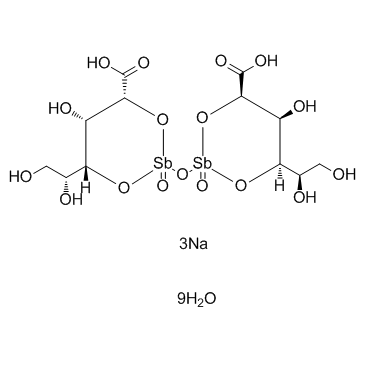CHEMICAL IDENTIFICATION
-
RTECS NUMBER :
-
CC7930000
-
CAS REGISTRY NUMBER :
-
16037-91-5
-
LAST UPDATED :
-
199712
-
DATA ITEMS CITED :
-
31
-
MOLECULAR FORMULA :
-
C12-H20-O17-Sb2.3Na.9H2-O
-
MOLECULAR WEIGHT :
-
1048.91
HEALTH HAZARD DATA
ACUTE TOXICITY DATA
-
TYPE OF TEST :
-
LD50 - Lethal dose, 50 percent kill
-
ROUTE OF EXPOSURE :
-
Intraperitoneal
-
SPECIES OBSERVED :
-
Rodent - mouse
-
DOSE/DURATION :
-
33 mg/kg
-
TOXIC EFFECTS :
-
Details of toxic effects not reported other than lethal dose value
-
REFERENCE :
-
CLDND* Compilation of LD50 Values of New Drugs. (J.R. MacDougal, Dept. of National Health and Welfare, Food and Drug Divisions, 35 John St., Ottawa, Ont., Canada)
-
TYPE OF TEST :
-
LD50 - Lethal dose, 50 percent kill
-
ROUTE OF EXPOSURE :
-
Subcutaneous
-
SPECIES OBSERVED :
-
Rodent - mouse
-
DOSE/DURATION :
-
7747 mg/kg
-
TOXIC EFFECTS :
-
Details of toxic effects not reported other than lethal dose value
-
REFERENCE :
-
IJPAAO Indian Journal of Pharmacy. (Bombay, India) V.1-40(1), 1939-78. For publisher information, see IJSIDW. Volume(issue)/page/year: 11,155,1949
-
TYPE OF TEST :
-
LD50 - Lethal dose, 50 percent kill
-
ROUTE OF EXPOSURE :
-
Unreported
-
SPECIES OBSERVED :
-
Rodent - mouse
-
DOSE/DURATION :
-
1625 mg/kg
-
TOXIC EFFECTS :
-
Details of toxic effects not reported other than lethal dose value
-
REFERENCE :
-
DRFUD4 Drugs of the Future. (J.R. Prous, S.A., Apartado de Correos 540, 08080 Barcelona, Spain) V.1- 1975/76- Volume(issue)/page/year: 18,451,1993 ** OTHER MULTIPLE DOSE TOXICITY DATA **
-
TYPE OF TEST :
-
TDLo - Lowest published toxic dose
-
ROUTE OF EXPOSURE :
-
Intramuscular
-
SPECIES OBSERVED :
-
Rodent - rat
-
DOSE/DURATION :
-
77537 mg/kg/30D-I
-
REFERENCE :
-
HETOEA Human & Experimental Toxicology. (Macmillan Press Ltd., Brunel Road, Houndmills, Basingstoke, Hampshire, RG21 2XS, UK) V.9- 1990- Volume(issue)/page/year: 11,283,1992 *** REVIEWS *** ACGIH TLV-TWA 0.5 mg(Sb)/m3 DTLVS* The Threshold Limit Values (TLVs) and Biological Exposure Indices (BEIs) booklet issues by American Conference of Governmental Industrial Hygienists (ACGIH), Cincinnati, OH, 1996 Volume(issue)/page/year: TLV/BEI,1997 TOXICOLOGY REVIEW FAZMAE Fortschritte der Arzneimittelforschung. Progress in Drug Research. (Birkhauser Boston, Inc., c/o Springer-Verlag New York, 44 Hartz Way, Secaucus, NJ 07094) V.1- 1959- Volume(issue)/page/year: 17,108,1973 *** U.S. STANDARDS AND REGULATIONS *** MSHA STANDARD-air:TWA 0.5 mg(Sb)/m3 DTLVS* The Threshold Limit Values (TLVs) and Biological Exposure Indices (BEIs) booklet issues by American Conference of Governmental Industrial Hygienists (ACGIH), Cincinnati, OH, 1996 Volume(issue)/page/year: 3,15,1971 OSHA PEL (Gen Indu):8H TWA 0.5 mg(Sb)/m3 CFRGBR Code of Federal Regulations. (U.S. Government Printing Office, Supt. of Documents, Washington, DC 20402) Volume(issue)/page/year: 29,1910.1000,1994 OSHA PEL (Construc):8H TWA 0.5 mg(Sb)/m3 CFRGBR Code of Federal Regulations. (U.S. Government Printing Office, Supt. of Documents, Washington, DC 20402) Volume(issue)/page/year: 29,1926.55,1994 OSHA PEL (Shipyard):8H TWA 0.5 mg(Sb)/m3 CFRGBR Code of Federal Regulations. (U.S. Government Printing Office, Supt. of Documents, Washington, DC 20402) Volume(issue)/page/year: 29,1915.1000,1993 OSHA PEL (Fed Cont):8H TWA 0.5 mg(Sb)/m3 CFRGBR Code of Federal Regulations. (U.S. Government Printing Office, Supt. of Documents, Washington, DC 20402) Volume(issue)/page/year: 41,50-204.50,1994 *** OCCUPATIONAL EXPOSURE LIMITS *** OEL-ARAB Republic of Egypt:TWA 0.5 mg(Sb)/m3 JAN 1993 OEL-AUSTRALIA:TWA 0.5 mg(Sb)/m3 JAN 1993 OEL-AUSTRIA:TWA 0.5 mg(Sb)/m3 JAN 1993 OEL-BELGIUM:TWA 0.5 mg(Sb)/m3 JAN 1993 OEL-DENMARK:TWA 0.5 mg(Sb)/m3 JAN 1993 OEL-FINLAND:.TWA (0.5 mg(Sb)/m3) JAN 1993 OEL-FRANCE:TWA 0.5 mg(Sb)/m3 JAN 1993 OEL-GERMANY:TWA 0.5 mg(Sb)/m3 (total dust) JAN 1993 OEL-HUNGARY:STEL 0.5 mg(Sb)/m3 JAN 1993 OEL-THE NETHERLANDS:TWA 0.5 mg(Sb)/m3 JAN 1993 OEL-THE PHILIPPINES:TWA 0.5 mg(Sb)/m3 JAN 1993 OEL-POLAND:TWA 0.5 mg(Sb)/m3 JAN 1993 OEL-RUSSIA:TWA 0.2 mg(Sb)/m3;STEL 0.5 mg(Sb)/m3 JAN 1993 OEL-SWEDEN:TWA 0.5 mg(Sb)/m3 JAN 1993 OEL-SWITZERLAND:TWA 0.5 mg(Sb)/m3 JAN 1993 OEL-TURKEY:TWA 0.5 mg(Sb)/m3 JAN 1993 OEL-UNITED KINGDOM:TWA 0.5 mg(Sb)/m3 JAN 1993 OEL IN BULGARIA, COLOMBIA, JORDAN, KOREA check ACGIH TLV OEL IN NEW ZEALAND, SINGAPORE, VIETNAM check ACGIH TLV *** NIOSH STANDARDS DEVELOPMENT AND SURVEILLANCE DATA *** NIOSH RECOMMENDED EXPOSURE LEVEL (REL) : NIOSH REL TO ANTIMONY-air:10H TWA 0.5 mg(Sb)/m3 REFERENCE : NIOSH* National Institute for Occupational Safety and Health, U.S. Dept. of Health, Education, and Welfare, Reports and Memoranda. Volume(issue)/page/year: DHHS #92-100,1992
|

